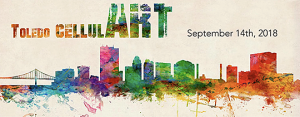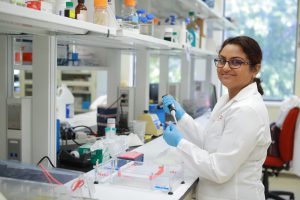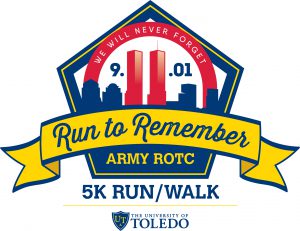Archive for September, 2018
Art and science set to collide at Toledo CellulART Sept. 14
Wednesday, September 12th, 2018This week The University of Toledo is hosting a one-day conference to celebrate and explore the creative side of cytoskeletal research.
Toledo CellulART, a regional meeting that brings together the art and scientific communities, will take place Friday, Sept. 14, in the UT Center for the Visual Arts, a building designed by world-renowned architect Frank Gehry on the Toledo Museum of Art Campus.
 CellulART celebrates the link between art and science while promoting collaboration, interaction and discussion between cytoskeletal researchers.
CellulART celebrates the link between art and science while promoting collaboration, interaction and discussion between cytoskeletal researchers.
This year the keynote talk will be given by Dr. Kenneth Yamada, National Institutes of Health Distinguished Investigator in the Cell Biology Division at the National Institute of Dental and Craniofacial Research in Bethesda, Md. He will speak at 1 p.m. in the basement auditorium.
The meeting also features a scientist/artist talk by Dr. Edna Cukierman, co-leader of the Pancreas Research Interest Group at the Fox Chase Cancer Center in Philadelphia. Her event is at 5:30 p.m. in the basement auditorium.
Throughout the day, there will be oral and poster presentations by faculty members, researchers, and undergraduate and graduate students. The poster and art presentations are from 2 to 4 p.m. in the student lounge on the third floor.
In addition to presentations by scientists in the UT Department of Biological Sciences, the conference features researchers from the University of Michigan, Purdue University, University of Notre Dame and Case Western Reserve University.
The meeting is sponsored by the American Society for Cell Biology; Cytoskeleton Inc.; Fisher Scientific International Inc.; and by the UT offices of the President and the Provost; the UT College of Natural Sciences and Mathematics; and the UT Department of Biological Sciences.
For more information, click here.
State honors UT for Latino community leadership
Wednesday, September 12th, 2018The Ohio Latino Affairs Commission selected The University of Toledo for its 2018 Governor’s Distinguished Hispanic Ohioan Award.
UT was chosen for the category of Nuestra Familia, or Our Family, which honors individuals or organizations that encourage the inclusion of Latinos in Ohio and are committed to making the state a welcoming place to all.
“We value and embrace our wonderfully diverse campus,” UT President Sharon L. Gaber said. “Diversity and inclusion are important to our success. In fact, it makes us stronger every day. Our investment and growth in Latino students, faculty and staff is important to who we are as a University, and we are honored to be recognized for our commitment.”
The award will be presented to Gaber Saturday, Oct. 27 at the 38th annual Governor’s Distinguished Hispanic Ohioans Gala at Lorain Community College in Elyria.
“The honor recognizes organizations within the state of Ohio who perform service of exceptional benefit to Latino Ohioans,” Dr. Gregory A. Guzman, commissioner of the Ohio Commission on Hispanic and Latino Affairs, said in a letter to Gaber. “The receiving organizations and individuals are always of good character and community standing exhibiting exceptional leadership, which The University of Toledo has certainly done.”
“The University is proud of the good work that we are doing with the Latino community,” Dr. Michele Soliz, associate vice president for student success and inclusion in the Division of Student Affairs, said. “From medical missions to Spanish-speaking countries to focusing on the success of Latino students, we are committed to the betterment of our communities. We are humbled to be recognized for this prestigious and competitive award. We look forward to working collaboratively with community members and forging new partnerships.”
UT scientists awarded nearly $1 million in federal grants to examine cell behaviors
Tuesday, September 11th, 2018The U.S. Department of Health and Human Services awarded nearly $1 million in federal grants to two scientists at The University of Toledo for research projects examining cell behaviors that can lead to the development of better medicines to treat cancer, cardiovascular disease and autoimmune disease.
“Once again one of our top-level Ohio universities proves that they are on the cutting edge of medical research and innovation,” said Congresswoman Marcy Kaptur. “Northern Ohio is a leader in medical research and these funds build on that foundation of excellence. These researchers are pushing boundaries and working to develop treatments and therapies to help those suffering from chronic illness. The University of Toledo distinguishes itself by competing and winning competitive grant opportunities such as the one announced today. I am pleased to be able to support their efforts to access federal research resources.”
Dr. Ajith Karunarathne, assistant professor in the UT Department of Chemistry and Biochemistry, received $441,323 from the National Institute of General Medical Sciences to examine the regulation of a crucial group of signaling pathways named G-protein and GPCRs that help the body control functions, including heart rate, and are involved in pathological processes such as cancer and heart disease.
“Knowledge from our experiments will help develop tissue- and organ-specific therapeutics for a variety of diseases, including cancer, that are less harmful to bodily functions,” Karunarathne said.
Dr. James Slama, professor in the UT Department of Medicinal and Biological Chemistry, received $461,898 from the National Institute of General Medical Sciences to identify the elusive receptor for nicotinic acid adenine dinucleotide phosphate, or NAADP, which could lead to the development of inhibitors that may be useful as anti-tumor drugs.
“This project is part of an effort to discover how cells in an organism control their behaviors, and how they can respond to changing outside conditions,” Slama said. “Calcium inside of the cell is an important controller, and a second chemical, named NAADP, is one of several substances that triggers internal calcium release. Our goal is to understand how NAADP causes this calcium release and to identify the individual steps in the process in both normal and in diseased states.”
UT chemists awarded $2.1 million to develop new antibiotic to treat TB
Tuesday, September 11th, 2018The National Institutes of Health awarded a team of chemists at The University of Toledo a five-year, $2.1 million grant to create a new, more effective drug to treat tuberculosis, the most common cause of death from an infectious disease worldwide.
The grant renews funding through 2023 for the project that combats drug resistance to current antibiotics.
 Dr. Donald Ronning and Dr. Steve Sucheck, professors in the UT Department of Chemistry and Biochemistry, will build on their progress made in the fight against Mycobacterium tuberculosis, which can be spread through coughing, sneezing or laughing and kills more people each year than HIV, malaria and the flu. It takes at least six months to clear the infection with the drugs currently available.
Dr. Donald Ronning and Dr. Steve Sucheck, professors in the UT Department of Chemistry and Biochemistry, will build on their progress made in the fight against Mycobacterium tuberculosis, which can be spread through coughing, sneezing or laughing and kills more people each year than HIV, malaria and the flu. It takes at least six months to clear the infection with the drugs currently available.
“Antibiotics discovered 60 years ago are becoming obsolete as bacteria naturally evolve to outsmart drug therapies,” Sucheck said. “Mycobacterium tuberculosis, which kills 1.5 million people a year, is one of a number of bacteria that have become increasingly drug resistant.”
“We’re designing an antibiotic to shorten the time it takes to clear the infection,” Ronning said. “Instead of six-to-24 months, we’re aiming for a therapy of two weeks, like treating strep throat or an ear infection, as well as reducing the side effects.”
The team has published several papers about breakthroughs in their ongoing research in several journals, including Nature Communications, Scientific Reports and the Journal of Biological Chemistry, as well as the American Chemical Society’s journals Biochemistry and Infectious Diseases.
“We’ve used x-rays to structurally characterize two targets and are making progress in understanding how to better hit those targets to make a molecule that is going to be much more potent against the bacterium that causes tuberculosis,” Ronning said.
The research centers around inhibiting two essential classes of enzymes found in Mycobacterium tuberculosis. One is called the antigen 85 Complex that the researchers learned changes shape as it performs its job in the cell, making the protein more vulnerable to some of the compounds the lab has been testing. The second enzyme class synthesizes long polymers of sugar. Inhibiting this enzyme promotes an accumulation of compounds toxic to the bacterium and leads to rapid killing.
“There is a tremendous need to identify new drugs and new drug targets that can be used to treat this increasingly drug-resistant bacteria,” Sucheck said. “We are creating something that has never been made. The work is urgent because many cases of TB are almost impossible to treat.”
UT professor awarded $2.6 million research grant to further work examining link between gut bacteria and high blood pressure
Monday, September 10th, 2018A University of Toledo researcher recently received a $2.64 million grant from the National Heart, Lung and Blood Institute to continue her groundbreaking research into how the unique colonies of tiny microorganisms living in our gut can regulate our blood pressure — or lead to hypertension.
High blood pressure is one of the most common ailments among American adults. According to figures from the U.S. Centers for Disease Control and Prevention, one in three adults has hypertension. And only about half of those have their condition under control. But even those who are actively controlling their hypertension are frequently just masking the problem.

Dr. Bina Joe, Distinguished University Professor and chair of UT’s Department of Physiology and Pharmacology and director of the Center for Hypertension and Precision Medicine
“Blood pressure medicines are not curing the cause. They are attacking it after its onset,” said Dr. Bina Joe, Distinguished University Professor and chair of UT’s Department of Physiology and Pharmacology and director of the Center for Hypertension and Precision Medicine. “If we know that there are some bacteria that shouldn’t be there and we can correct it early on, will that lead to better health as a preventative measure?”
The hope is that the grant-funded research could ultimately lead to breakthroughs that would give clinicians a way to treat or even prevent high blood pressure by manipulating those microorganisms, also known as microbiota.
Researchers have long known that our genes can predispose us to high blood pressure. But only more recently — thanks in large part to the research by Joe’s team at The University of Toledo — has the medical community begun to realize how the microorganisms living in our bodies play a role in that equation.
“A human is an ecosystem,” Joe said. “We have one host and so many microbiota. Together they influence several traits for normal health.”
The four-year grant will allow Joe’s lab and co-investigators from her department, Drs. Matam Vijay-Kumar and Ritu Chakravarti, to dig deeper into that connection in three ways:
- First, researchers will look into how an individual’s genome determines which microorganisms flourish in their guts.
- Second, researchers will look at the effects of high salt consumption on the animals’ microbiota. Salt can kill bacteria, and it’s possible, Joe says, that high salt intake can disturb the microbiota that are beneficial to maintenance of normal blood pressure.
- Third, researchers will look at epigenetics — essentially how gene function can be altered by environmental factors and diet.
Though the work is still early, Joe and her graduate student, Saroj Chakraborty, have already been granted a patent. Researchers isolated a certain chemical called beta hydroxybutyrate that increases with exercise, but decreases with salt consumption. Joe said it’s possible that exercise benefits hypertension in part because of the higher concentration of that compound.
The lab fed hypertensive rats a precursor of that molecule to see if their blood pressure decreased.
“Sure enough, it did,” Joe said. “Our idea is if there are people who cannot exercise but they’re salt sensitive hypertensives, here could be a magic pill. You could take a bit of this chemical so you don’t have to keep running but you can control your blood pressure. That’s unpublished data coming from this work, currently in peer review.”
Some of Joe’s earlier work on microbiota and hypertension also is getting attention for its intersection with the growing worry that overuse of antibiotics is leading to an increase in drug-resistant superbugs.
Research led by her lab found that common antibiotics could lead to a spike in blood pressure for certain individuals, while other antibiotics may actually reduce blood pressure in hypertensive patients.
The reason for that discrepancy appears to be tied to how the antibiotics interact with an individual’s microbiota.
The findings, which were recently published in the journal Physiological Genomics, could lead to additional studies that hone a more individualized approach for physicians to consider when using antibiotics to treat infection.
“I think this study is hugely important for the future of prescribing antibiotics. They’re prescribed so often to hypertensive individuals, and this study shows that can have a really negative affect on their blood pressures,” said Sarah Galla, an MD-PhD candidate who worked with Joe on the study.
“This highlights the importance of more studies that need to be done to further the field of personalized medicine, rather than just prescribing the same antibiotic to every patient.”
UT Army ROTC to host Run to Remember Sept. 11
Wednesday, September 5th, 2018The University of Toledo’s Army ROTC Program will host the Run to Remember, a 5K run and walk on Main Campus, Tuesday, Sept. 11.
After the race, a moment of silence with chimes from University Hall’s bell tower will occur at 8:46 a.m., the time when the attacks began in 2001.
 “We are planning to make this an annual event. It’s important that we never forget,” Master Sgt. Johnnie Fields, UT senior military instructor and commandant of cadets, said. “Bringing together the UT and Toledo communities makes us all stronger.”
“We are planning to make this an annual event. It’s important that we never forget,” Master Sgt. Johnnie Fields, UT senior military instructor and commandant of cadets, said. “Bringing together the UT and Toledo communities makes us all stronger.”
The race will take place on the UT track by the Health Education Center. Free parking will be available in lots 1S, 5 and 6.
Registration and T-shirt pickup will begin at 6:30 a.m. The opening ceremony will start at 7 a.m., with the race and walk at 7:15 a.m. In addition, there will be a closing ceremony.
To register for the race, visit utmemorial5k.myevent.com or visit the event table Sept. 11.
“The goal of this event is to honor those who made the ultimate sacrifice on that day and have people show their support and donate to a good cause,” Fields said.
Although the event is free, a $5 donation is recommended from participants. Funds raised will go to the National September 11 Memorial and Museum.

